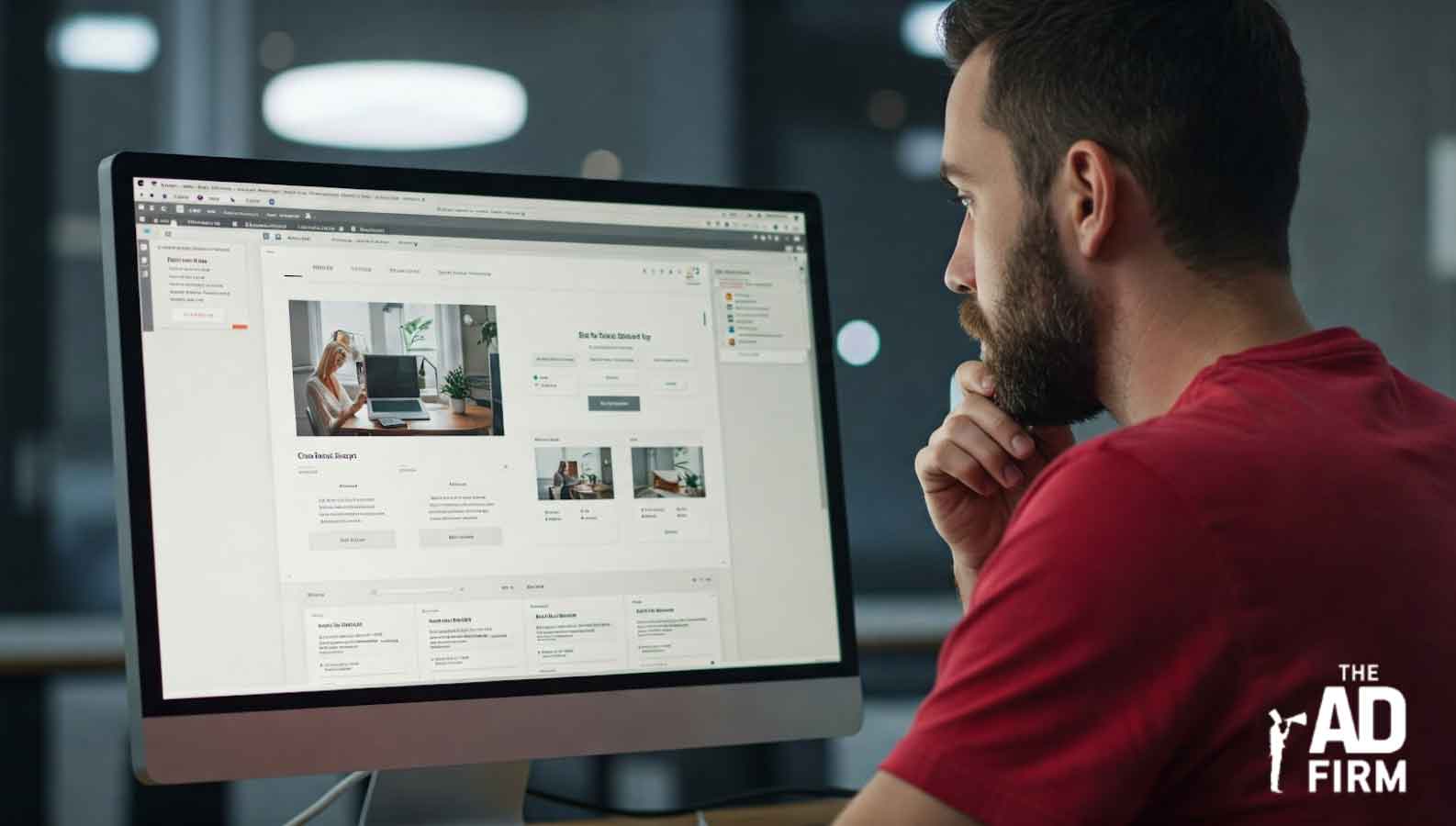Modern web design has come a long way from the past’s overly stripped-down, all-white layouts.
Today’s users are moving fast. They want websites that feel intuitive, look polished, and help them get what they need without friction. That’s why clean, accessible web design is having a moment again, but this time, it’s smarter and more strategic.
In this guide, we’ll explore how clean web design has evolved in 2025 and why it’s become a critical part of creating websites that feel intuitive, professional, and built for today’s users.
How Clean Web Design Has Changed and Why It Matters
Clean web design is all about clarity, focus, and simplicity. It removes distractions so users can get where they need to go quickly and without confusion.
But the definition of “clean” has changed, and for good reason.
It’s No Longer Just About White Space and Aesthetics
In the past, the goal was to create a minimal, uncluttered appearance, but that often focused more on style than function.
For example:
- White space was used mainly for visual effect. Large empty areas between sections made pages feel spacious, but they didn’t always help people understand where to go or what to do next.
- Color and images were kept to a bare minimum. Many sites stuck to black, white, and gray tones, sometimes to the point where they felt lifeless or uninviting.
- Layouts were overly simplified. Some websites removed so much content that users were left guessing what the business actually did. Without enough explanation, direction, or helpful text, visitors often left confused or unsatisfied.
Clean Design in 2025 Is All About Function and Ease of Use
Today, clean web design focuses on how a site works, not just how it looks. In 2025, a “clean” website should:
- Make navigation easy and obvious. Visitors should instantly know how to get around. Simple menus, clear buttons, and a straightforward page structure help users find what they’re looking for without guessing.
- Feel smooth across all devices. Whether someone is on a phone, laptop, or tablet, a clean site loads quickly and functions without delays or glitches.
- Support what the user needs at that moment. Content is explicit and purposeful. Each section on the page is there for a reason, not just to “fill space,” but to guide someone toward the next step or answer their question.
- Create a stress-free experience. Clean design reduces friction. There’s no visual noise, confusing popups, or over-designed layouts that leave users wondering what to click next.
Clean design in 2025 matters because it’s not just about first impressions; it’s about creating a better experience from start to finish. Attention spans are short, and patience for clunky design is even shorter.
Transform Your Online Strategy with The Ad Firm
- SEO: Achieve top search rankings and outpace your competitors with our expert SEO techniques.
- Paid Ads: Leverage cutting-edge ad strategies to maximize return on investment and increase conversions.
- Digital PR: Manage your brand’s reputation and enhance public perception with our tailored digital PR services.
When a site feels messy, overwhelming, or slow, users move on fast. But when the experience is simple, intuitive, and built around conversion-critical web design elements, users stay longer, trust what they see, and are far more likely to take action.
Why Clean Design Works Better in 2025
In 2025, a clean, clutter-free website is one of the most effective ways to improve user experience and stay competitive online.
Here’s why:
- Faster load times: When a website avoids unnecessary graphics, heavy animations, and bloated layouts, it loads much faster. This is especially important for mobile users, who expect instant access and may leave if a page takes too long.
- Better experience on phones and tablets: A clean site is easier to navigate on small screens. There’s no endless scrolling, zooming, or dealing with pop-ups that block the content. Everything feels more accessible and stress-free.
- Clear focus on what matters: When there’s less visual noise, your most important messages stand out like your headline, your main services, or a “Contact Us” button. Visitors don’t have to search for what they need.
- It builds trust: A simple, organized, and optimized layout makes your business look more professional. When people land on a clean site, they’re more likely to feel confident that they’re in the right place and that your business is reliable.
- Search engines prefer user-first sites: Google now favors websites that put people first. Clean, well-structured pages help search engines understand your content better, which can boost your visibility in search results.
- It just feels better: Think of a website that loads instantly, has a clear headline, a few strong visuals, and one obvious next step. No clutter. No confusion. That kind of experience feels good, and that’s what keeps people coming back.
How to Make Your Website Feel Clean Without Stripping It Bare
A clean website doesn’t mean removing everything until the page feels empty. It means intentionally using space, text, and structure in a way that feels clear, helpful, and easy to use.
Here’s how to make your website feel clean without overdoing the minimalism.
Use Space to Help People Understand What They’re Looking At
When everything on a page is packed too closely together, it becomes hard to read and even harder to know where to look first. That’s why spacing matters.
Advance Your Digital Reach with The Ad Firm
- Local SEO: Dominate your local market and attract more customers with targeted local SEO strategies.
- PPC: Use precise PPC management to draw high-quality traffic and boost your leads effectively.
- Content Marketing: Create and distribute valuable, relevant content that captivates your audience and builds authority.
Instead of squeezing everything onto one screen:
- Separate sections clearly: Use padding and margins between blocks of content so visitors can easily tell where one idea ends and the next begins. For example, a noticeable space between your product grid and customer reviews makes both easier to focus on.
- Let buttons and CTAs stand out: Add generous space around key actions like “Contact Us” or “Shop Now.” Instead of using bold colors or effects to force attention, spacing guides the eye there naturally.
- Avoid dense paragraphs: No one wants to squint through walls of text. Leave space around important messages so they’re easier to spot and more inviting to read. Break large blocks into shorter sections with clear headings or bullets to guide the reader’s eye.
Think of spacing as the invisible guide that helps visitors understand what to look at first, next, and last.
Keep the Writing Short and Easy to Follow
Long paragraphs and complicated wording make websites harder to read. Most visitors are scanning, not reading every word, so how you write makes a big difference.
To keep things readable:
- Break content into small pieces: Use bullet points, short paragraphs, and clear headers to make scanning easier. Visitors should be able to get the main idea just by skimming.
- Cut the fluff: Every sentence should serve a purpose. If a piece of text doesn’t help someone understand your offer or take action, consider cutting it.
Clean writing reinforces clean design. When your content is focused, everything else falls into place more easily.
Make It Clear How to Get Around the Site
People shouldn’t have to guess where to click or how to find your services, contact form, or products.
Here’s how to keep your structure simple and helpful:
- Stick to the essentials in your main menu: Limit your top navigation to the most important pages, like “Home,” “Services,” “About,” and “Contact.” When a menu is packed with too many choices, visitors may feel overwhelmed and unsure of where to start. A focused menu helps users quickly understand what your site offers and gets them to the right place without hesitation.
- Use clear, familiar labels: Skip the creative or abstract wording. Use simple, straightforward terms that people instantly understand. For example, instead of saying “Discover” or “Explore Our World,” go with “Our Services” or “Products.” Clarity builds confidence, and when visitors aren’t confused by what a link means, they’re far more likely to click.
- Make mobile navigation a priority: On phones and tablets, small screens mean your design needs to work even harder. Make sure buttons are large enough to tap without frustration, and avoid hiding key links under lengthy menus or difficult-to-read text. A smooth mobile experience makes your site feel modern and professional, and keeps users from giving up and leaving.
When the layout feels predictable, people feel more confident using your site and are more likely to stick around.
Amplify Your Market Strategy with The Ad Firm
- PPC: Master the art of pay-per-click advertising to drive meaningful and measurable results.
- SEO: Elevate your visibility on search engines to attract more targeted traffic to your site.
- Content Marketing: Develop and implement a content marketing strategy that enhances brand recognition and customer engagement.
Use a Small Set of Fonts and Colors and Use Them the Same Way
Fonts and colors don’t just make your site look nice, they influence how people feel when they interact with it. Too many styles can feel chaotic and confusing. Clean design keeps things unified.
Here’s how to create consistency:
- Stick to two fonts: One for headings (like Montserrat or Lato) and one for body text (like Open Sans or Roboto). This keeps the reading experience smooth and avoids jarring visual shifts.
- Choose a simple color palette: Pick 2 to 3 primary colors for your brand. One can be used for accents (like buttons or links), one for backgrounds or structure, and one for text or contrast. For example, blue for CTAs, gray for backgrounds, and black for text.
- Repeat design choices across all pages: Use the same button style, spacing, and header size on every page. That kind of visual rhythm helps users feel oriented and builds brand recognition.
A unified look builds trust. If everything looks and feels consistent, users don’t have to question if they’re still on your site; they can just focus on what you’re offering.
Take the Next Step Toward Cleaner, Smarter Web Design
If your website feels cluttered, slow, or outdated, now’s the time to rethink your approach. A clean, intentional design helps users feel more confident, stay longer, and take action.
At The Ad Firm, we design websites that do more with less. Our streamlined, user-first approach helps businesses create fast, modern sites that look good and work hard across every screen and click.
Ready to modernize your website and make simplicity your advantage in 2025?
Contact us and let’s build something better together.





